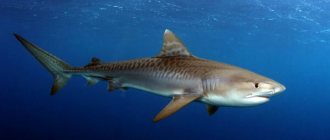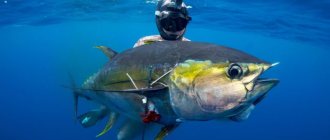Sharks are the almost undisputed queens of the seas and oceans. There are more than 450 types of them - from small to large . The smallest of them reaches a length of only 17 cm. Most are much larger. Some are very big. They made it into the presented top 10 largest sharks .
By the way, it would be a mistake to consider the toothy inhabitants of the World Ocean exclusively as predators. Among them there are also quite peaceful creatures that pose no danger to living beings. By the way, some of the species live in freshwater bodies. The largest shark in the world , of course, will not be found in fresh water, but quite large specimens can be found far from the seas.
Next is a list and description of the largest sharks in the world .
Mako shark
This is not only one of the largest, but also one of the most aggressive sharks. They show their character already in the mother’s womb - embryos actively fight for the right to live. Natural selection does its job, and the most dangerous individuals are born.
The length of the mako is up to 3.5 m. The largest specimen surprised fishermen with its size of 4.5 m. Like the famous white shark, the mako can be dangerous to humans. Even its appearance makes it similar to white. But in most cases, attacks on people are caused by the latter’s intrusion into the “sphere of influence” of the mako. Although there are also troubles caused by the excessive aggression of the white-like species.
Among other things, makos are very agile and fast. The maximum speed of movement of a large shark is 70 km/h. An aerodynamic aquatic inhabitant from the herring family is capable of jumping out of the water to a height of up to six meters.
Big shark - big authority
Sharks, according to most scientists, grow throughout their lives, i.e. can reach very huge sizes under a successful combination of circumstances. By and large, every giant shark whose photographs excite the imagination is a true champion of survival in the underwater world.
Indeed, among all its fellow tribesmen, it was this individual that was able to survive childhood and adolescence, avoiding the role of the “main dish” for many predators, among which were its larger brothers.
For sharks, as well as for other representatives of the ocean fauna, achieving large sizes is like a jackpot in roulette - this is the best preventive protection against any, even the largest predators, for whom it is much easier and simpler to attack small prey than to expose themselves to danger in a fight with giant.
Sixgill shark
The maximum officially confirmed length is 5.4 m. This makes the sixgill a participant in this rating. But the size of ordinary representatives of the species is more modest - within 3-4 meters.
It poses no danger to humans. But he doesn’t like being touched by divers and can’t even stand it. In such situations, it simply rushes to the depths. But it can rush – its capabilities allow a shark with six gills to descend to a depth of up to 2.5 km.
Usually one of the largest sharks is quite slow and clumsy. But when attacking, she transforms - she becomes sharp and fast.
Extinct shark
Feast of humpback whales
Such huge predatory creatures as megalodons must have had a serious appetite. The open mouth of the ancient shark could reach colossal sizes - 3.4 by 2.7 meters.
They could eat prey of any size - from small animals (such as dolphins, other sharks and sea turtles) to huge humpback whales. Thanks to its powerful jaws, the bite force of which could range from approximately 110 thousand to 180 thousand Newtons
, Megalodon inflicted terrible wounds, crushing the bones of the victim.
As mentioned earlier, scientists have found fossilized remains of whale skeletal bones with bite marks from a megaladon. Thanks to these finds, scientists were able to study exactly how the terrible predators devoured their victims.
Some bones even preserved pieces of the tips of the megaladon's teeth, which broke off when attacked by ancient sharks. These days, great white sharks also hunt whales
, but prefer to attack cubs or weakened (wounded) adults, which are easier to kill.
Megadolon lived everywhere
In its heyday, the ancient megalodon shark could be found in oceans around the world. This is evidenced by finds in the form of the teeth of this predator, which are found almost everywhere.
Fossilized remains belonging to these monstrous creatures
, have been found in North and South America, Europe, Africa, Puerto Rico, Cuba, Jamaica, Canary Islands, Australia, New Zealand, Japan, Malta, the Grenadines and India.
In other words, if these territories were under water millions of years ago and there was food in them, then megalodon also lived there. It is believed that the lifespan of the ancient shark ranged from 20 to 40 years, but it is possible that some representatives of this species lived longer.
Another advantage that megalodons had was that they were geothermal animals.
. This means that these giant sharks were able to maintain a constant body temperature regardless of the external temperature.
Thus, the oceans of the entire planet were open to megalodons. Now this ancient shark is the object of attention mainly of cryptozoologists. Indeed, there is virtually no chance that we will ever encounter a living megalodon.
Despite this, we should not forget, for example, about the coelacanth - a lobe-finned fish, which turned out to be a living fossil; or about the yeti crab - a furry crab living in the area of hydrothermal vents, which was discovered only in 2005
, when the submarine sank to a depth of 2200 meters.
Megalodon preferred shallow depths
It is quite difficult to imagine that such a huge predator as megalodon could live anywhere other than the deepest parts of the world's oceans. However, as recent findings show, these sharks preferred to swim near coastal areas.
Staying in warm, shallow coastal waters allowed megalodons to effectively produce offspring. Researchers from the University of Florida, USA, reported the discovery of fossil remains ten million years old.
very young megalodons in Panama.
More than four hundred fossilized teeth were discovered, collected from shallow waters. All these teeth belong to very small baby ancient sharks. Similar remains of cubs were found in the so-called Valley of Bones in Florida, as well as in the coastal areas of Calvert County, Maryland, USA.
And although newborn megalodons were already impressive in size (on average from 2.1 to 4 meters, which is comparable to the size of modern sharks), they were vulnerable to various predators (including other sharks)
. The ocean is an extremely dangerous place for any newborn predators, so the sharks tried to stay in shallow water to give their offspring the best chance of survival.
Megalodon was very fast
Megalodons were not only gigantic in size - they were also very fast for their size. In 1926, a researcher named Leriche made an astonishing discovery, discovering a more or less preserved vertebral column of a megalodon.
This column consisted of 150 vertebrae. Thanks to this discovery, researchers were able to learn much more about the behavior and habits of these giant sharks. Having studied the shape of the vertebra, scientists came to the conclusion that the megalodon clung to the victim with its powerful jaws
, and then began to move his head from side to side, trying to tear a piece of flesh from the bones.
It was this hunting style that made the ancient shark such a dangerous predator - once caught in its jaws, the victim had no way to escape from there. Again, thanks to the shape of its body, megalodon could reach speeds of 32 kilometers per hour or more.
White sharks also develop great speed in a jerk, but for the size of a megalodon its speed is considered simply incredible. It is believed that in their normal state, ancient sharks moved at an average speed of 18 kilometers per hour
. But even this speed was enough for the megalodon to be faster than many other species in the ocean.
However, if you believe other experts, in particular, eminent scientists from the Zoological Society of London, this speed was higher. Some researchers believe that megalodon had the ability to move through water at an average speed that exceeds the average speed of any modern shark.
Largemouth pelagic shark
Next is a large-mouthed shark, whose “face” resembles the space pirates without disguise from the children’s TV series “Guest from the Future.” These beauties (sharks, I mean) are poorly studied, and they were discovered relatively recently - in the seventies. To date, only 60 deep-sea largemouths have been discovered. The largest shark of them reaches a length of 5.7 m.
How big were megalodons?
A megalodon tooth next to two large white shark teeth for comparison
Much of what we know about this long-gone basking shark comes from analysis of its teeth. The largest tooth specimen found is about 18 centimeters in length. Modeling performed on the recovered teeth showed that the megalodon had a robust dental structure with approximately 250 teeth and jaws that extended approximately 2 meters.
Several attempts have been made to reconstruct the jaws, from which it was possible to estimate the actual size of the shark. In 2002, Kenshu Shimada, a paleontologist at DePaul University, developed an improved model for predicting specimen size from tooth length.
Using this model, Shimada predicted the total length of various samples found in the Panamanian Gatun Formation. The largest of them was estimated at approximately 17.9 meters.
In 2022, Shimada made certain changes to his model, in which he stated that analyzing the upper front teeth of a sample provided more accurate results. Using these changes, he calculated that megalodon sharks longer than 15.3 meters were extremely rare.
On the other hand, according to the Natural History Museum in London, the largest specimen could stretch up to 18 meters.
Reconstructed Megalodon jaws are on display at the National Aquarium, Baltimore.
According to medieval texts, large teeth often found in rocks are believed to be the fossilized tongues of dragons. It was not until 1667 that Nicholas Stenot was able to identify them as shark teeth.
fox shark
The sea fox was included in the rating thanks to its huge tail fin. Together with him, the predator reaches a length of about 6 m. But, since you cannot throw the tail out of the body, the cunning representative of sharks reasonably occupies a high position.
Despite its predatory nature, this species is not dangerous to humans. The king of nature causes fear in the fox shark, and the “tailed” cartilaginous fish attacks only its smaller marine colleagues.
The shark's long tail is used as a whip. They use it to stun prey. In English they have a special, additional name - thresher shark.
The huge sea fox is capable of jumping completely out of the water. These are fast and powerful predators.
The final three in the Top 10 giant sharks
In eighth place is the common sea fox shark (Alopias vulpinus), with a body length of about 6 meters and a weight of up to 900 kg.
This type of shark is called “thresher” for its original way of hunting fish: the shark circles around a school, whipping the water into foam with its tail fin and surrounding the frightened fish with this air net.
Ninth place goes to the sixgill shark (Hexanchus griseus). Some individuals of this shark species grow up to 5.5 meters in length, reaching 800 kilograms in weight.
The hunting grounds of adult sixgill sharks are located at great depths. Sometimes these predators were found at a depth of 2500 meters.
The last place - tenth - among giant sharks is occupied by a relative of the common sea fox - the big-eyed sea fox (Alopias superciliosus). The greatest height of sharks of this species is 5 meters, weight is about 760 kg.
Hammerhead shark
This shark is impressive not so much in size as in “design”. The hammer-shaped snout does not make the fish a beauty, but it definitely elevates it to the rank of the most original sea creatures.
The average dimensions of the “hammers” are 3 meters. But the maximum length that is officially recorded is 6.1 m. This is a potentially aggressive and dangerous fish, and it is better to stay away from it. But statistics say that hammerhead sharks are rarely interested in people. It is up to the divers to decide who to trust – statistics or probability.
GIANT SHARK SIGHTINGS
The giant shark visits the British Isles region in the summer and can also be seen in the Baltic Sea. However, the largest concentrations of this fish are observed in the Atlantic Ocean around Ireland and Scotland. At the end of April - beginning of May, you can see giant sharks here, which absorb huge masses of copepods that swim on the surface - this is their main food. In places rich in food there are schools of these fish, numbering about 20-30 individuals. At the end of November, basking sharks move into deep sea areas. In winter, these fish do not feed. The distinctive features of this shark are its large dorsal fin and enormous body size.
Tiger shark
Photos of the largest sharks always include images of tiger species. The average size of sea tigresses is 5 m. There is every reason to believe that the oceans are full of tiger sharks measuring at least 7 meters.
Some representatives of these predators can be found in the largest aquarium in Moscow →
the giant tigress - it is not only a very large shark, but also a rather aggressive shark. Human remains are often found in the stomachs of these fish. In some countries, there are so many tiger sharks that they are shot to ensure the safety of people.
What are they eating
The giant creature feeds on zooplankton, just like the blue whale, for example. Its usual food is fish eggs, small crustaceans, and various invertebrates that live in the water column and have tiny body sizes. Just in order to catch its dinner, the shark has to constantly swim with its mouth open.
This may seem tedious, but the shark never worries about lunch: as soon as you open your mouth, the food itself will end up in the stomach, having undergone a filtration procedure using gills. Since its body size is enormous, the shark almost always swims with its mouth open in order to obtain the required amount of food. And although the width of the mouth of the largest sharks often exceeds 1 meter and they could theoretically swallow not only large fish, but also a person, they never do this. To date, not a single case of their aggressive behavior towards people has been recorded, and even sea vessels do not cause them concern. This circumstance ultimately turned against them: being too trusting of people, they often become an accidental catch in fishing nets.
White shark
The most famous species, causing at least mixed emotions in any normal person. The man-eating shark is known for its aggressiveness, powerful jaws and a huge number of human victims. The white shark is the greatest actress who has appeared in films countless times.
The largest white shark (of those that were caught) was 7.9 m long. There is information that larger specimens roam the oceans - up to 12-13 m. But the average size of predators is 4-5 m. The average weight is 0. 6-1.2 t.
Despite its popularity and reputation, this species is considered endangered - according to ichthyologists, there are about 3.5 thousand killer carcharodons left in the world.
What does Megalodon look like?
Reconstructed megalodon skeleton at the Calvert Maritime Museum in Maryland
While the scientific community is split over the exact appearance of the long-extinct shark species, the one thing they all agree on is that it had a large, robust body. Many believe that Megalodon may have looked like a great white shark, albeit much larger and with wider jaws.
Others have concluded that the ancient shark is very similar to the whale shark, the largest living fish species. The arrangement of the fins and other anatomical features (crescent-shaped caudal fins, smaller second dorsal and anal fins) may have been identical to those of whales and other extant shark species.
Arctic Greenland shark
This huge cutie with a model look is one of the largest and slowest sharks. The usual size of a polar shark is 6-7 m. But the speed is let down - the northern species moves no faster than 2.5 km/h. Even for a one and a half ton fish, this is very little, but these are the conditions of its habitat - low temperatures do not favor sharks for maneuverability and agility.
With such slowness one could die of hunger, but the polar beauty looks for victims on its own. All that remains for her is to attack the seals sleeping in the water.
Blacktip shark
A representative of herring sharks with an elongated body and a sharp snout. It grows up to 4.45 m in length, weight can reach 280 kg. The color of the back is dark blue, the belly is white. Has the ability to maintain body temperature above the environment. Lives in the waters of temperate and tropical seas. Mako sharks, as this species is called differently, are characterized by incredible speed and aggressiveness, and can attack people. They usually hunt near the surface of the water, grabbing prey from below. They feed on a variety of fish and can attack smaller sharks and, in rare cases, dolphins and other marine mammals.
Giant (or gigantic) shark
In second place is the basking shark, the largest of the relatively dangerous sharks. The photo is not the most pleasant - the gaping mouth is both scary and disgusting. The size of females is about 10 m. Males are slightly smaller. A couple of centuries ago, fishermen caught 12-meter specimens. There is an opinion that even today it is quite possible to come across a truly giant shark - up to 15 m long.
Do you know which dogs are the biggest? →
However, the likelihood of meeting even an ordinary representative of the species is very low - due to the mass extermination of these sharks, there are only a few of these sharks left. The horror story feeds on plankton and small fish, but it is better for humans not to swim near it. The shark has sharp scales that can easily hurt.
You are already one step away from finding out how much the largest shark weighs , its size and its diet.
The basking shark is a slow hunter with a peaceful disposition.
Surprisingly, the largest sharks can be considered peaceful. The giant shark is not at all aggressive. It lives primarily in temperate waters of the southern hemisphere. It is forced to migrate periodically by a lack of food, namely plankton, which forms the basis of its diet.
The giant fish reaches 12 meters in length and can weigh about 10-12 tons. The individual does not intentionally hunt, like the whale shark; it prefers to move smoothly and slowly, capturing plankton along with food.
i.pinimg.com
These are the huge sharks they are. Their smaller relatives are much more dangerous. Find out more facts about sharks.
Whale shark
The largest shark on the planet is the whale shark . The average length is 12-15 m, but more impressive dimensions are not uncommon - 18-20 m. The weight of the largest specimen is 36 tons.
To satisfy their hunger, a “mid-size” whale needs at least 200 kg of plankton. Almost every schoolchild probably knows that the biggest shark in the world
When and how did Megalodon go extinct?
In 2014, researchers from the University of Zurich conducted a study to determine the age of megalodon fossils using a method called Optimal Linear Estimation. The study found that this species of shark went extinct approximately 2.6 million years ago, which is approximately 200,000 years before Homo habilis (the earliest known ancestors of Homo sapiens) first appeared on Earth.
In 1873, the British survey ship HMS Challenger discovered a pair of well-preserved megalodon teeth. Their analysis incorrectly showed them to be about 10,000-15,000 years old; There's no way it's going to be close to the set range. This discrepancy is most likely due to the presence of manganese dioxide, which can effectively reduce the rate of decomposition.
During the existence of megalodon, sharp climatic changes occurred on the planet. Global cooling, which began about 35 million years ago, led to glaciation of the poles, while temperatures worldwide dropped by 8°C.
Declining Earth's temperatures and expanding glaciers at the poles disrupted marine habitats, ultimately leading to the loss of various aquatic species, including megalodon. This could have contributed to the extinction of many species.
Because megalodon sharks depend on warm waters, the sudden drop in temperatures likely limited their habitats. Their food may also have become scarce (either migrated to colder regions or disappeared completely).
Great white shark in Mexican waters / Photo Credit: Wikimedia Commons
An interesting theory behind the extinction of the megalodon is the emergence of great white sharks. The youngest megalodon fossil dates back to 3.6 million years, a million years earlier than previously thought, according to a new study by a team of international researchers.
The study further notes that these dates coincide with the first appearance of the great white shark on Earth. Great white sharks, although smaller, may have outcompeted the young to the point that the entire species was wiped out.
Megalodon
What's a hit collection without surprises? Many a question: what does another species have to do with this if we have already decided on the first position? In fact, the whale fish is indeed the largest in size. But - in modern realities. Among the extinct species, another fish is in the lead.
The megalodon shark is the undisputed record holder of those distant times and species. Unfortunately, the largest shark was not included in the video - the fossil fish disappeared long before the development of our technologies. According to scientists, the size of the mega-fish was in the range of 12-18 m. At the same time, the largest shark in the world, megalodon, was heavier than a modern whale - about 50 tons. Due to its size, the shark even fed on similar, but smaller, species.
The biggest shark ever
Megalodon
It would seem that here it is, a list of the largest and heaviest sharks that exist in the World Ocean. But I wouldn’t want to end here, because I want to tell you something more about large sharks. Scientists around the world are finding huge teeth of a predatory shark, which are 3 or more times larger than the teeth of a great white. This is a megalodon, and fortunately it has long been extinct. The size of the population of this predator in the past is evidenced by the fact that these teeth are found everywhere, they were even discovered in the Mariana Trench.
Whale bones with traces of these teeth are also found, but few other remains are found. After all, sharks are cartilaginous fish, and the only strong bones in their skeletons are their teeth. But the appearance of the megalodon was still restored; the shark turned out to be truly huge. During the time of dinosaurs, it definitely had something to eat, but later the species became extinct. The largest modern shark was the whale shark, which feeds on plankton, and the largest of the predatory sharks was the great white.
Interesting: Why are sharks afraid of dolphins? Reasons, photos and videos
CHARACTERISTIC FEATURES OF THE GIANT SHARK
Mouth: The shark swims with its mouth open.
Gill filaments: bright red thin plates that absorb dissolved oxygen.
Filtering apparatus: plankton is retained by the shark's gill rakers covered with sticky mucus.
Eating food: water containing oxygen and food enters the shark’s mouth, where it is filtered with the help of gills. Plankton is retained by the gill rakers, and oxygen is actively absorbed by the surface of the gill filaments. Carbon dioxide is removed from the body along with water through the gill slits located on the sides of the fish's head.
— Habitat of the giant shark
WHERE DOES HE LIVE?
The giant shark is found in all seas and oceans of the temperate zone of both hemispheres.
PROTECTION AND PRESERVATION
The size of the population, due to the lack of ability to keep records of individual individuals, is determined only approximately. The danger for them is posed by excessive fishing, which leads to disruption of the ecological balance and causes a decrease in the amount of food for sharks.











